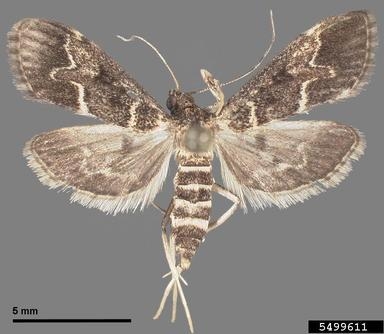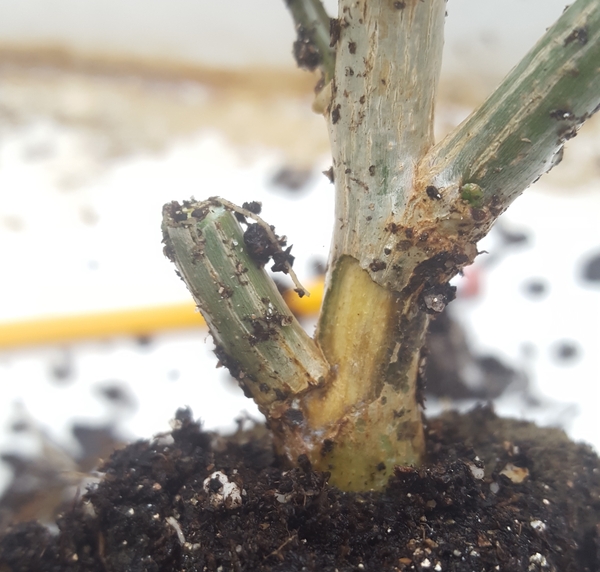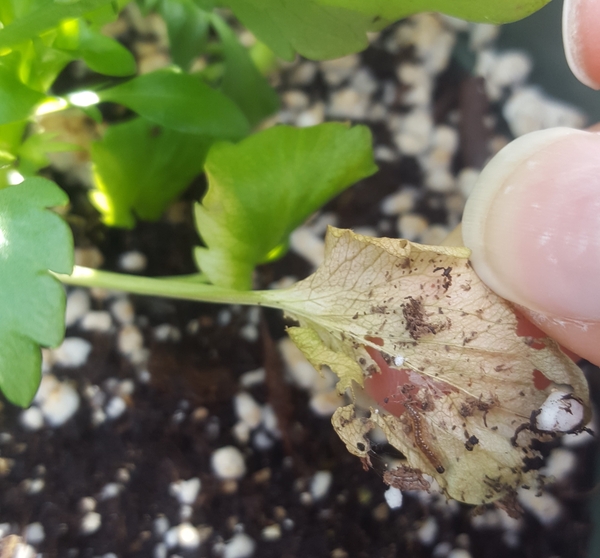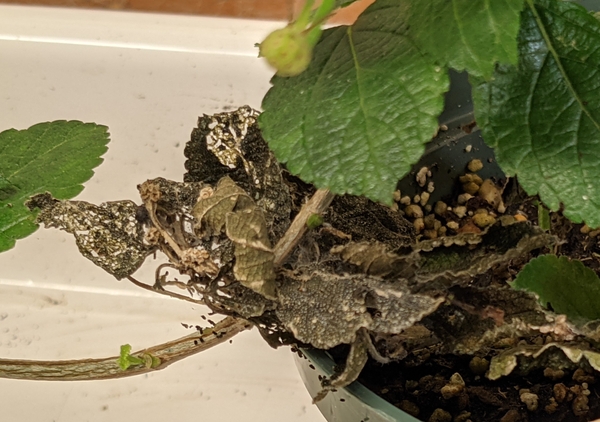Identification and Biology
The adults are brown moths with wing spans up to 21 mm (Figure 1 and Figure 2). The forewings have a characteristic finger-shaped line that points toward the wing edge. The abdomen is brown with cream or white rings at each abdominal segment. Male moths bend their abdomen tips upward. Eggs are less than 1 mm, white to pink, and laid on the undersides of leaves singly or in small groups.
When eggs hatch young larvae feed on leaves for a time before moving down the plant to feed at the soil surface. Here larvae build silk webs for protection and feed on lower leaves, stems, and roots.
Larvae are white to light brown with rows of dark brown spots on their abdomen (Figure 3). However, the color of their abdomen can change based on their host plant and possibly the substrate in which they live. Their head is shiny dark brown to black. Larvae live in silk webbing which can also help identify them.
Pupae are within a cocoon made of silk, soil, and plant debris. Cocoons are up to 21 mm but are difficult to find.
There are probably 3-5 generations per year in central North Carolina. Development from egg to adult requires about a month depending on temperature. Since this species is originally from Mediterranean areas it is not tolerant of freezing. Thus, it occurs outdoors in warm areas and in greenhouses or other protected culture in cold areas.
Damage
European pepper moth larvae are the damaging life stage of this pest. Larvae can feed on and damage all parts of many plant species (Figure 4). Larvae damage leaves especially when young before moving to the soil (Figure 5). Larvae feed on the base of stems which can interfere with water transport and even cause plants to collapse. Symptoms of feeding also include wilting and stunted growth when stems are girdled or roots are damaged.
Some commonly infested ornamental plants include: Begonias, ornamental peppers, poinsettia mums, coleus, lantana, kalanchoe, azalea, impatiens, geraniums, and many others. Most herbs are damaged as well as many vegetables including tomatoes, peppers, cucumbers, celery, and others (Figure 6).
Scouting and Monitoring
Scouting is difficult because larvae are on the soil surface or even below the soil for most of their lives. If plants display wilting or other symptoms similar to drought when water is plentiful it is especially important to scout for larvae. Look for fine silk webbing on the soil surface tangled in plant debris and media particles. There may also be feeding on lower leaves or damage to the stems.
Monitor for adults with pheromone lures to determine when adults are active and eggs are being laid. Phermone lures only attract male moths so there is no risk of increasing or causing an infestation by using them.
Decision Making
There are no established thresholds based on larval density for this pest. Typically of you find a few larvae there are others present and damage can happen quickly as they grow and feed. If you trap adult moths it means European pepper moths are in your area. It is a good idea to scout and potentially treat your most vulnerable plants during adult flight because this is when egg laying is happening.
Intervention & Control
Cultural Control
There are no cultural control measures established so far. However, some plant species are more vulnerable or preferred by European pepper moth. These species may be scouted more frequently. In addition, since the larvae are not cold tolerant, leaving plants outdoors during winter instead of in cold frames or other protected situation may reduce the larvae that survive in your crop.
Biological Control
There is not established biological control protocol for this pest. Biological-based insecticides including Beauveria bassiana and Bacillus thuringiensis may be effective but more work is required on these products. Nematodes may also be effective but require further evaluation.
Chemical Control
One of the most important aspects of chemical management for European pepper moth larvae is the application technique. Since larvae live at the soil surface sprench applications are generally recommended. Sprench is a foliar application with low pressure and large droplets so the insecticide also covers the soil surface. In research so far pyrethroids do not appear to be effective. Products that are effective for other caterpillars seem effective for European pepper moth larvae in many cases. Anthranilic diamides have good lepidopteran efficacy and show good efficacy for this pest also. These include chlorantraniliprole, cyantraniliprole, and cyclaniliprole. Methoxyfenozide is another lepidopteran active chemical with efficacy against European pepper moth. More research is underway to identify other effective insecticides.
Publication date: July 12, 2022
N.C. Cooperative Extension prohibits discrimination and harassment regardless of age, color, disability, family and marital status, gender identity, national origin, political beliefs, race, religion, sex (including pregnancy), sexual orientation and veteran status.
NC Cooperative Extension prohíbe la discriminación por raza, color, nacionalidad, edad, sexo (incluyendo el embarazo), discapacidad, religión, orientación sexual, identidad de género, información genética, afiliación política, y estatus de veteran.
Recommendations for the use of agricultural chemicals are included in this publication as a convenience to the reader. The use of brand names and any mention or listing of commercial products or services in this publication does not imply endorsement by NC State University or N.C. A&T State University nor discrimination against similar products or services not mentioned. Individuals who use agricultural chemicals are responsible for ensuring that the intended use complies with current regulations and conforms to the product label. Be sure to obtain current information about usage regulations and examine a current product label before applying any chemical. For assistance, contact your local N.C. Cooperative Extension county center.
N.C. Cooperative Extension prohibits discrimination and harassment regardless of age, color, disability, family and marital status, gender identity, national origin, political beliefs, race, religion, sex (including pregnancy), sexual orientation and veteran status.






